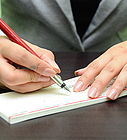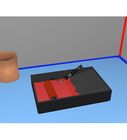How to Choose a Paint Brush
Choosing good paint brushes for your art is an important step in gathering your art materials. Here are some guidelines to consider when making your purchases.
EditSteps
-
1Familiarize yourself with the brushes. Typically, an artist will have many different types of brushes for different techniques and painting methods:
- Round: a brush with the bristles curving into the center at the ends, excellent for control and accuracy.
- Flat: along with the Filbert brush, this is a mainstay in your brush fleet. Great for edging and filling in areas.
- Filbert: a staple brush in your collection, it is flat with rounded corners.
- Bright Brush: this brush is the same as a flat brush, but with shorter bristles for details and different spring-action.
- Rigger Brush: round, narrow, long-bristled brush for making lines and detail work.
- Fan Brush: a flat brush with bristles fanned out, ideal for delicate blending.
- Angle Brush: multi-purpose brush similar to flat brush, but cut at an angle.
- Mop Brush: this rounded brush has longer bristles and will droop when loaded with paint, great for splotching and dragging thinned paint around.
Ad -
2Familiarize yourself with different hair-types. There are different materials used for brushes:
- Bristle - usually the cheapest - made from pig hairs. This is a standard brush that you would find often in artists' collections.
- Synthetic - these can be cheap or expensive and they have a different feel than natural hair brushes.
- Sable - usually the most expensive - made from various other fine-haired animals, such as sables, weasels, and other rodents.
-
3Choose a brush that feels good and is well-built:
- The bristles should spring back into shape easily, for most applications. Shorter bristles will obviously spring back faster. Think about how it will be affected when loaded with paint.
- The ferrule should be well-attached to the handle and the brush bristles should not be loose.
- The handle should be preserved well. If left in water, painted handles will expand and crack the paint. If you'll be using turpentine, that may damage the finish on your brushes.
- The length of the handle will determine how you will be handling the strokes. Shorter handles are for close-up detailed work, while longer handles will facilitate distance slashing motions.
-
4Look for sales at art supply stores. If you are a student, be sure to go to stores that honor student discounts. Paying full price for art supplies is rarely wise, as artists are not known for being wealthy.
-
5Collect together one of each of these brushes and additional sizes of the main workhorse brushes - the flat and the filbert. You may also want a very wide flat brush (like a 2" wide house painting brush) for covering very large areas initially.
-
6Learn about the different ways each brush can be held and the different ways of making strokes. This knowledge will also come with experimentation, which is clearly the best way to learn. What you are trying to accomplish will generally decide which brush is best for which job.Ad
We could really use your help!
estate planning?

e-commerce?

viral videos?

Adobe Photoshop?

EditVideo
| This video covers the different types of brushes and uses. |
EditTips
- Brushes can get quite expensive, so take care of them: don't leave them sitting in water, don't get paint up into the ferrule (the metal part), and wash and dry your brushes thoroughly right after use.
- Go with what works for you. If a cheaper brush does a better job and feels right, use that instead. You don't always have to have the most expensive items.

























